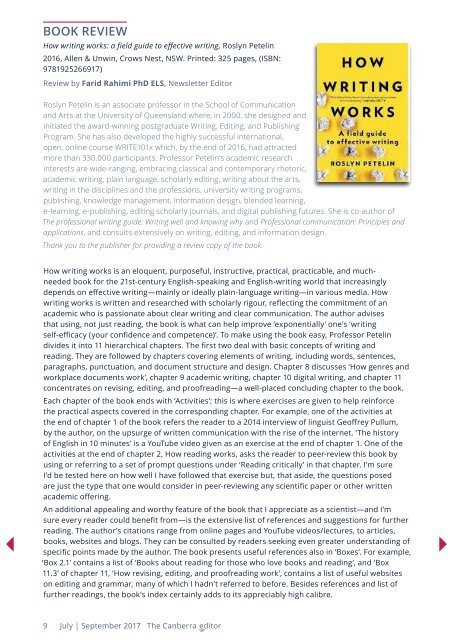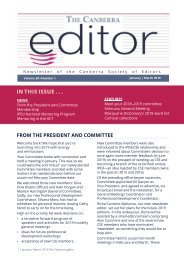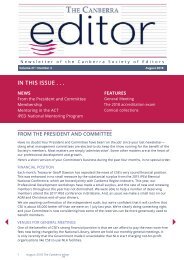The Canberra Editor July-September 2017
Newsletter of the Canberra Society of Editors
Newsletter of the Canberra Society of Editors
You also want an ePaper? Increase the reach of your titles
YUMPU automatically turns print PDFs into web optimized ePapers that Google loves.
BOOK REVIEW<br />
How writing works: a field guide to effective writing, Roslyn Petelin<br />
2016, Allen & Unwin, Crows Nest, NSW. Printed: 325 pages, (ISBN:<br />
9781925266917)<br />
Review by Farid Rahimi PhD ELS, Newsletter <strong>Editor</strong><br />
Roslyn Petelin is an associate professor in the School of Communication<br />
and Arts at the University of Queensland where, in 2000, she designed and<br />
initiated the award-winning postgraduate Writing, Editing, and Publishing<br />
Program. She has also developed the highly successful international,<br />
open, online course WRITE101x which, by the end of 2016, had attracted<br />
more than 330,000 participants. Professor Petelin’s academic research<br />
interests are wide-ranging, embracing classical and contemporary rhetoric,<br />
academic writing, plain language, scholarly editing, writing about the arts,<br />
writing in the disciplines and the professions, university writing programs,<br />
publishing, knowledge management, information design, blended learning,<br />
e-learning, e-publishing, editing scholarly journals, and digital publishing futures. She is co-author of<br />
<strong>The</strong> professional writing guide: Writing well and knowing why and Professional communication: Principles and<br />
applications, and consults extensively on writing, editing, and information design.<br />
Thank you to the publisher for providing a review copy of the book.<br />
How writing works is an eloquent, purposeful, instructive, practical, practicable, and muchneeded<br />
book for the 21st-century English-speaking and English-writing world that increasingly<br />
depends on effective writing—mainly or ideally plain-language writing—in various media. How<br />
writing works is written and researched with scholarly rigour, reflecting the commitment of an<br />
academic who is passionate about clear writing and clear communication. <strong>The</strong> author advises<br />
that using, not just reading, the book is what can help improve ‘exponentially’ one’s ‘writing<br />
self-efficacy (your confidence and competence)’. To make using the book easy, Professor Petelin<br />
divides it into 11 hierarchical chapters. <strong>The</strong> first two deal with basic concepts of writing and<br />
reading. <strong>The</strong>y are followed by chapters covering elements of writing, including words, sentences,<br />
paragraphs, punctuation, and document structure and design. Chapter 8 discusses ‘How genres and<br />
workplace documents work’, chapter 9 academic writing, chapter 10 digital writing, and chapter 11<br />
concentrates on revising, editing, and proofreading—a well-placed concluding chapter to the book.<br />
Each chapter of the book ends with ‘Activities’; this is where exercises are given to help reinforce<br />
the practical aspects covered in the corresponding chapter. For example, one of the activities at<br />
the end of chapter 1 of the book refers the reader to a 2014 interview of linguist Geoffrey Pullum,<br />
by the author, on the upsurge of written communication with the rise of the internet. ‘<strong>The</strong> history<br />
of English in 10 minutes’ is a YouTube video given as an exercise at the end of chapter 1. One of the<br />
activities at the end of chapter 2, How reading works, asks the reader to peer-review this book by<br />
using or referring to a set of prompt questions under ‘Reading critically’ in that chapter. I’m sure<br />
I’d be tested here on how well I have followed that exercise but, that aside, the questions posed<br />
are just the type that one would consider in peer-reviewing any scientific paper or other written<br />
academic offering.<br />
An additional appealing and worthy feature of the book that I appreciate as a scientist—and I’m<br />
sure every reader could benefit from—is the extensive list of references and suggestions for further<br />
reading. <strong>The</strong> author’s citations range from online pages and YouTube videos/lectures, to articles,<br />
books, websites and blogs. <strong>The</strong>y can be consulted by readers seeking even greater understanding of<br />
specific points made by the author. <strong>The</strong> book presents useful references also in ‘Boxes’. For example,<br />
‘Box 2.1’ contains a list of ‘Books about reading for those who love books and reading’, and ‘Box<br />
11.3’ of chapter 11, ‘How revising, editing, and proofreading work’, contains a list of useful websites<br />
on editing and grammar, many of which I hadn’t referred to before. Besides references and list of<br />
further readings, the book’s index certainly adds to its appreciably high calibre.<br />
9 <strong>July</strong> | <strong>September</strong> <strong>2017</strong> <strong>The</strong> <strong>Canberra</strong> editor

















